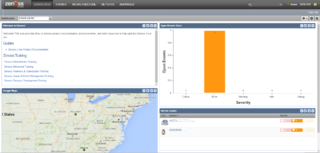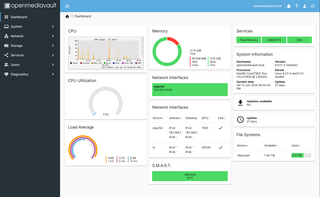
In computing, a database is an organized collection of data or a type of data store based on the use of a database management system (DBMS), the software that interacts with end users, applications, and the database itself to capture and analyze the data. The DBMS additionally encompasses the core facilities provided to administer the database. The sum total of the database, the DBMS and the associated applications can be referred to as a database system. Often the term "database" is also used loosely to refer to any of the DBMS, the database system or an application associated with the database.
Middleware in the context of distributed applications is software that provides services beyond those provided by the operating system to enable the various components of a distributed system to communicate and manage data. Middleware supports and simplifies complex distributed applications. It includes web servers, application servers, messaging and similar tools that support application development and delivery. Middleware is especially integral to modern information technology based on XML, SOAP, Web services, and service-oriented architecture.

WebObjects is a discontinued Java web application server and a server-based web application framework originally developed by NeXT Software, Inc.
Nagios is an event monitoring system that offers monitoring and alerting services for servers, switches, applications and services. It alerts users when things go wrong and alerts them a second time when the problem has been resolved.
A GIS software program is a computer program to support the use of a geographic information system, providing the ability to create, store, manage, query, analyze, and visualize geographic data, that is, data representing phenomena for which location is important. The GIS software industry encompasses a broad range of commercial and open-source products that provide some or all of these capabilities within various information technology architectures.

Mantis Bug Tracker is a free and open source, web-based bug tracking system. The most common use of MantisBT is to track software defects. However, MantisBT is often configured by users to serve as a more generic issue tracking system and project management tool.

A LAMP is one of the most common software stacks for the web's most popular applications. Its generic software stack model has largely interchangeable components.

The company Zenoss, Inc. was founded in 2005 and is headquartered in Austin, Texas. The company develops hybrid IT monitoring and analytics software.
The following tables compare general and technical information for a number of notable network monitoring systems. Please see the individual products' articles for further information.

Shinken is an open source computer system and network monitoring software application compatible with Nagios. It watches hosts and services, gathers performance data and alerts users when error conditions occur and again when the conditions clear.

NConf is an open source tool for configuring the Nagios network monitoring system. It is mainly targeted at sysadmins who are looking for a more convenient way of managing their Nagios configuration files through the use of a graphical user interface, as opposed to maintaining the configuration files with a text editor.

OpenMediaVault (OMV) is a free Linux distribution designed for network-attached storage (NAS). The project's lead developer is Volker Theile, who instituted it in 2009. OMV is based on the Debian operating system, and is licensed through the GNU General Public License v3.
Checkmk is a software system developed in Python and C++ for IT Infrastructure monitoring. It is used for the monitoring of servers, applications, networks, cloud infrastructures, containers, storage, databases and environment sensors.

Actian Zen is an ACID-compliant, zero-DBA, embedded, nano-footprint, multi-model, Multi-Platform database management system (DBMS). It was originally developed by Pervasive Software, which was acquired by Actian Corporation in 2013.

Fat-Free Framework is an open-source web framework distributed under the GNU General Public License and hosted by GitHub and SourceForge. The software seeks to combine a full featureset with a lightweight code base while being easy to learn, use and extend.

Apache Spark is an open-source unified analytics engine for large-scale data processing. Spark provides an interface for programming clusters with implicit data parallelism and fault tolerance. Originally developed at the University of California, Berkeley's AMPLab, the Spark codebase was later donated to the Apache Software Foundation, which has maintained it since.

Naemon is an open-source computer system monitoring, network monitoring and infrastructure monitoring software application. Naemon offers monitoring and alerting services for servers, switches, applications, and services. It alerts the users when things go wrong and alerts them a second time when the problem has been resolved. Naemon was created in 2014 as a fork of Nagios.

Octopussy, also known as 8Pussy, is a free and open-source computer-software which monitors systems, by constantly analyzing the syslog data they generate and transmit to such a central Octopussy server. Therefore, software like Octopussy plays an important role in maintaining an information security management system within ISO/IEC 27001-compliant environments.

Alyvix is an open source software application developed in Python for System monitoring and IT monitoring, synthetic monitoring and application performance management on Windows computers. It is used for visually monitoring fixed applications, streamed and cloud applications, and websites, as well as for robotic process automation.

















